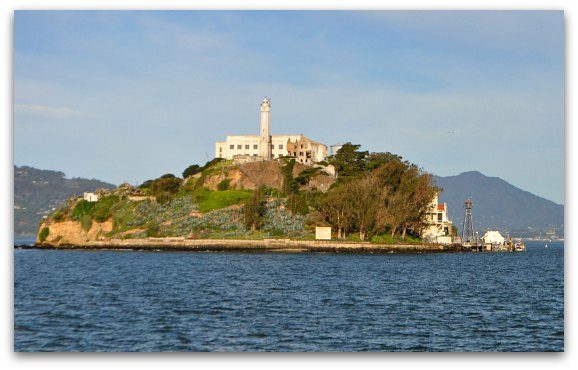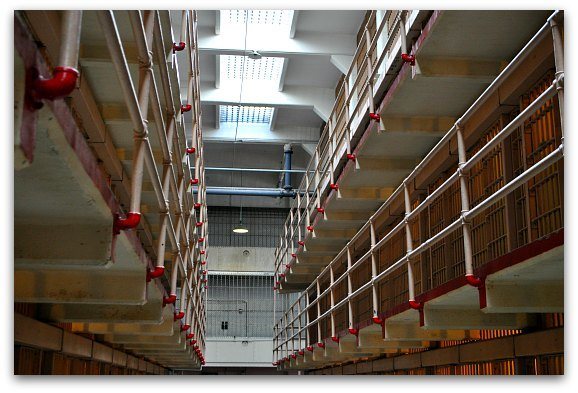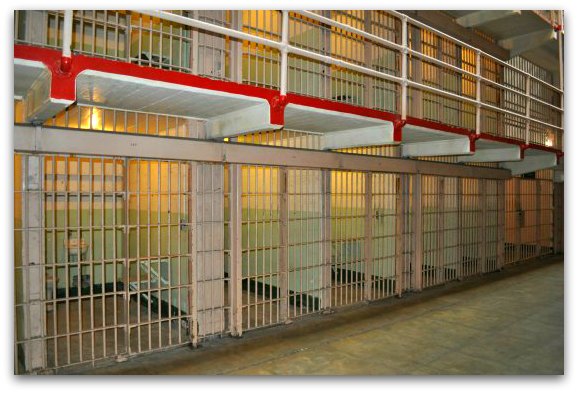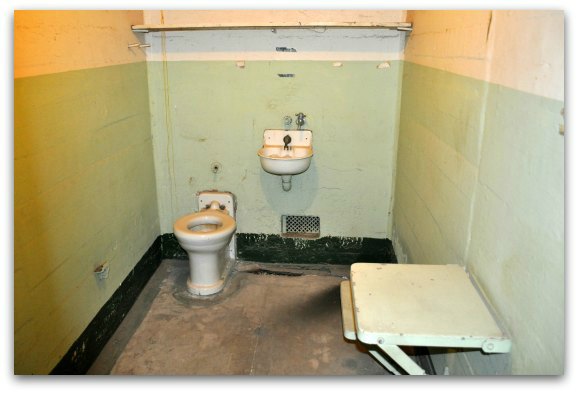SIGN UP FOR MY EMAIL TO RECEIVE YOUR FREE SAN FRANCISCO PLANNING GUIDE.
- Home
- Alcatraz Prison Tours
Alcatraz Prison Tours: Booking Tickets, Ferry Schedule & Other Tips to Book
By: Jill Loeffler • Updated: June 2, 2025
Alcatraz Prison tours are a must for every visitor to San Francisco. With over one million visitors every year, it's one of the most popular SF attractions and one I've been fortunate to explore more than a dozen times.
I highly recommend that you pick up your tickets right away, as they sell out quickly. However, there are also a few ways to find tickets for sold-out days.
SFTourismTips is made possible by readers like you! If you book through my links, I may earn a small commission at no extra cost to you. Thanks for your support! Learn more.
Highlights for Alcatraz Prison Tours
- Alcatraz is open daily. It is only closed on Thanksgiving Day, Christmas Day, and New Year's Day.
- Tickets start at $47.95 for adults for the Day Tour. The Night Tour starts at $59.65. The Behind the Scenes Tour is the most expensive and starts at $104.65 per person.
- The day tour usually lasts about 2 to 3 hours. The night tour is a little longer.
- The ferry to Alcatraz is included in your ticket. Ferries leave from Pier 33, which is along the Embarcadero.
- Tickets often sell out in advance, so make sure to pick up your tickets as early as you can before you arrive.
Combo Tickets that Include Alcatraz Tours
Everything You Need to Know to Book Alcatraz Prison Tours
- What types of Alcatraz Prison tours are available? Which tour is best? Is it better at night or during the day?
- How long is the tour? How long can you stay on the island? Can you take pictures?
- How far in advance do you need to buy tickets? What if tickets are sold out? How do I get last-minute tickets? How much does it cost? Are discounted tickets available?
- What time of day is best to visit? Is it better to visit in the morning or in the afternoon? What time of year should I visit?
- Is the tour worth it?
- What do I need to do to prepare for my visit, including what I should wear, how to find my ferry, and more about visiting the island? Check out my visitors' guide to help you prepare for your visit.
Three Types of Tours are Available
You will find three types of Alcatraz Prison tours. All include a ferry ride to and from San Francisco.
1. Early Bird & Day Tours
When you purchase your tickets, you will find there are two separate tour options. However, everything about them is the same except for the time they leave.
The Early Bird Tour is the first Day Tour that leaves in the morning. Both cost the same and offer the exact same experience, except with the Early Bird Tour, you are the first to arrive on the island.
The day tours include a self-guided audio tour that walks you through a pre-determined route in the main building on the island.
It includes some history for several locations within the main cell block, along with descriptions about life on the island from ex-inmates and guards.
It lasts about 45 minutes.
Once you complete the audio portion, you are free to roam the open areas on your own. You can visit the gift shop, where you can purchase T-shirts, books, and other items about the island. You can also join one of the scheduled, guided walks or discussions.
You will find a list of the special programs on this board as you enter the building before you start your visit (shown in the picture above). It allows you to plan your time while on the island.
Unfortunately, you can't get a schedule of these when you book your ticket, since all of them are offered by volunteers. However, if you are able to experience one, this is another great benefit of the Alcatraz Prison tours and a great way to learn more about this site's history.
The day tour is great since you can spend as much time as you want. You can also take any ferry back to San Francisco, so there is no rush during your tour.
For most people, the day trip lasts about 2.5 to 3 hours.
>> Tips for taking the ferries to Alcatraz
2. Night Tour
The Night Tour is my favorite since the groups are smaller and there are fewer people on the island. It also includes a few more stories told by the park rangers. You can either stop and listen to them or head to the main prison building to start your self-guided audio tour (same as in the day tour).
One question I get a lot about the Alcatraz night tour is if it's scary. The night tour is not scary. It's very similar to the day tour. There are fewer people on the island, and you get a more personalized experience.
They run only twice a night. There are also just two return ferries. These tours run in the late afternoon, even though they are referred to as night tours.
They also only run a few nights a week. Most of the night tours are about 3 to 3.5 hours.
Click here for additional details on what it's like on the night tour.
3. Behind the Scenes Tour
The Behind the Scenes tour of Alcatraz Island runs once a day, every Thursday - Monday. It is all year round and is limited to less than 30 people per tour.
This Alcatraz Prison tour offers specialized treatment during your visit, accompanied by a guided tour.
The tour starts with narration on your cruise during your journey. Once you reach Alcatraz Island, you will then be treated to a guided tour of places on the island that few people get the chance to see.
They show you hidden doorways, basement cells, and tell you interesting stories about this historic gem.
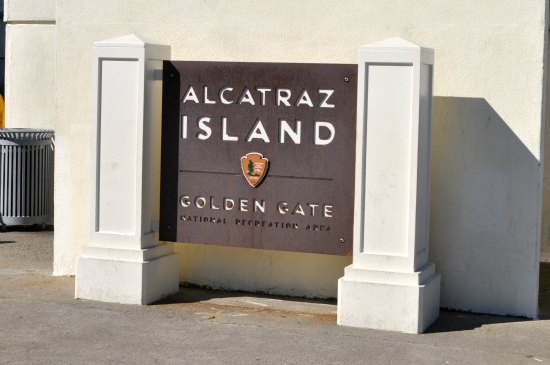 Many people enjoy taking their photos next to this official sign to prove that they were lucky enough to visit!
Many people enjoy taking their photos next to this official sign to prove that they were lucky enough to visit!Once the guided tour is complete, you will then set off on your own for the self-guided audio tour of the prison. This part of the tour lasts about 45 minutes.
The Behind the Scenes Alcatraz tour lasts about 4.5 hours. It is quite a bit more strenuous than the other tours, as you will be climbing steep stairs and walking around on uneven pavement. Keep this in mind as you select which one is right for you.
All participants for this tour must be 13 or older. Please note that refunds will not be issued if you purchase a ticket for someone under 13 who is not allowed to go.
This cruise leaves in the late afternoon and returns in the evening.
>> More about the Behind the Scenes Tour of Alcatraz
What are Combo Tours?
Another option for Alcatraz Prison Tours is the combo tours. Most of these tours offer tickets to the day tour of the island as well as a ticket for another San Francisco activity, including a city tour, the hop-on-hop-off bus, or a visit to Muir Woods.
The benefit of buying these tickets is that you can save a little money compared to buying them separately. All of these tickets are sold through tour companies, so they do the work to set everything up for you.
The majority of these combo tours only include access to day tour tickets. Here are some of the best-selling combo tickets.
The Best Alcatraz Tour Options
Now that you know all about the types of Alcatraz Prison tours, you probably want to know which one is the best? My favorite is the night tour for a few reasons.
First, there are fewer people on the island since all the day tour participants have left. Second, you get a more personalized experience since there are also fewer people on each night tour.
Another reason I love the night tour more is that there are usually additional areas open on the island that aren't open during the day. This is how I had a chance to see the prison's hospital area and other rooms above the cell blocks.
The downside to the night tour is that it operates only a few times a week, with only one to two tours daily, resulting in fewer tickets available for each. They are also more expensive than the day tour.
I also love the Behind the Scenes tour. These run during the day and leave with the night tour ferries, so there are a lot of people around at the beginning of the tour, but fewer by the time you head over for your self-guided audio tour.
However, you also get to go to places in the main jailhouse that others do not.
Since there are only a limited number of tickets available each day, you will want to plan ahead, as they can be hard to get.
The combo tour tickets are best for those who already plan to do other activities in addition to their visit to Alcatraz. These are all-day tickets to the island plus a ticket to another tour or activity. My favorite is the combo ticket with the Hop On Hop Off Bus.
You can use it to get to Pier 33 for your Alcatraz Prison Tour and then use it to get to your next destination.
Is it Better During the Day or the Night?
Visiting Alcatraz is interesting both during the day and at night. You will get a great sense of what it was like to live on the island and what it must have been like to be a prisoner here.
The day tours are fascinating and offer the most flexibility. The night tours are amazing, but keep in mind they leave in the late afternoon and return between 6 pm and 8 pm, depending on the time of year.
So, which one is better? I prefer the night tour, but not because of the time it leaves. I prefer it because it's a more personalized experience. However, it takes longer, is more expensive, and the tickets are harder to get since it only runs a few times a week.
Typically, when I visit, I head over during the day as early as I can. It's a peaceful place first thing in the morning. You can easily get your tour in, explore the island for an hour, and then return to San Francisco for lunch. This also gives you more time to explore the city.
Length of Alcatraz Prison Tours
The minimum time for the day tours is about 2 to 3 hours. This includes the 15 minutes each way on the ferry to get to and from the island.
The night tours run about 3 hours, including the time on the ferry.
The Behind the Scenes tour takes anywhere from 4.5 to 5 hours.
All of these are estimates, as you can leave the island when you are ready to return, and a ferry is available.
How Long You Are Allowed to Stay
You can stay on Alcatraz until the last ferry. The last ferry for the Alcatraz Prison tours during the day leaves around 3 pm. Depending on the season, the last ferry returns to Pier 33 at 3:50 pm or 6:40 pm.
For the night tours, there are usually only one to two return ferries. They make sure there is room for everyone, so you can stay until the last night ferry leaves.
Depending on the season, the last ferry can return as late as 9:40 pm to Pier 33.
Pictures Inside Alcatraz
Yes, can take pictures everywhere within Alcatraz. There are no restrictions on taking photographs as long as you are in an area open to the public.
Make sure to look out the windows because you can get some great photos of places on the island that are not open to the public.
At times, they do have traveling exhibits on the island. Each of these has a different photography policy, so make sure to check with them on any restrictions on these exhibits.
Ticketing Details
How far in advance do you need to buy Alcatraz tickets?
The Alcatraz Prison Tours are going on sale several months in advance.
I recommend booking your tickets as soon as you know your dates. They don't typically sell out on the very first day the tours open, but sometimes they will sell out a day or two after.
You can also consider combo tickets, which offer a bit more flexibility when booking your dates. Tour companies are given an allotment of tickets to sell, and most people purchase these much closer to their date of travel.
They are also a great place to look for sold-out dates.
>> Tips on how far in advance you need to book other SF attractions
What if Alcatraz tickets are sold out? How do you get last minute Alcatraz tickets?
I receive emails regularly from people searching for tickets to Alcatraz Prison tours on days that are sold out on the official website.
Once those are sold out, there are no places I'd recommend booking individual tickets. However, my secret to solving this issue is to look for and book a combo tour (package) that includes other attractions or activities as well as Alcatraz tickets.
The best place to look is on GetYourGuide.
They consolidate tickets from local tour companies, giving you a comprehensive view of what's still available for your dates.
Get Your Guide
Below are some of the top combo tour options on Get Your Guide. Click the pictures to find out what options are available on the date of your visit.
How much does it cost to go to Alcatraz?
Alcatraz Prison Tours tickets range from $47.95 for the day tours to $104.65 for the Behind the Scenes Tour. The day tour tickets are the least expensive.
Are discounted tickets available?
Many people search for discounted Alcatraz tickets. You won't find any reputable companies selling these tickets.
Since Alcatraz sells out most of the year, they never offer their tickets at a discount. I specifically point this out as I want you to be very careful of fraudulent tickets.
I recommend purchasing your tickets either directly through Alcatraz Cruises, a reputable site such as GetYourGuide, or at the ticket counter (tickets will only be available here during the low season).
If you think you found an amazing deal and/or discount on Alcatraz tickets, it's most likely a scam. If you're unsure, please don't hesitate to reach out to me, and I'll do my best to help you determine if the deal is legitimate.
Best Times to Visit
What time of day is best to visit Alcatraz? Is it better to visit Alcatraz in the morning or afternoon?
I highly recommend getting the earliest ticket in the day that is available. The Early Bird tickets are best since you are the first group on the island.
I also like getting there as early as possible because then you can participate in some talks on the island. These usually start around 11 a.m. with the final ones in the early afternoon.
If you arrive around noon, you will miss the opportunity to listen to these talks, as you'll need to take your self-guided audio tour first.
What time of year should I visit?
There are a few considerations you'll want to look at when booking your tickets for Alcatraz Prison tours. The warmest months in San Francisco are September and October.
This is the best time to visit the island as the main Cellblock is a little warmer than the rest of the year.
That being said, this is San Francisco, so make sure you plan accordingly and bring long pants and a jacket. It can get mighty foggy and windy on the island, and you don't want to be caught out there without some way to keep warm.
January and February are a little cooler as it's the rainy season. However, tourism is quieter during that time of the year. This is a great time to visit if you don't want to battle the crowds as much. There is covered seating on the ferry, so they won't cancel them due to rain.
Visit the San Francisco weather section for a month-to-month look at the weather.
Are the Alcatraz Prison Tours Worth It?
Yes, this is a must-see when you are in San Francisco. It's best for those interested in history and stories about the inmates. If those two things don't interest you, then you can skip this attraction.
The self-guided audio tour is great. You will hear voices from an inmate with great sound effects. It gives you an honest feeling for what it must have been like to live on the island.
You will also learn more about the escape attempts, including the one by Frank Lee Morris and the Anglin brothers in 1962.
You can then make your own decision if you think they made it to the shore alive. You can also read a little more about that one here before your visit.
Exhibits at Alcatraz
Alcatraz is now starting to use some of their buildings for special exhibits. They have featured the works of famous artists such as Ai Weiwei, as well as others that focus on topics related to prisons, prisoners, or human rights.
Access to these exhibits is included with your standard tickets for all Alcatraz Prison tours.
More Great Tips for Alcatraz
Read More About the History of Alcatraz
The following sections are dedicated to the history of this island. Discover details on its infamous prisoners, escape attempts, and some general history of the island. It's a great way to learn a little more before you head over for one of these fun Alcatraz Prison tours.
Robert "The Birdman of Alcatraz" Stroud
Stroud was another famous prisoner on Alcatraz Island—one of the few to become famous after he went to prison. Discover details around the crime that sent him to jail and why he was sent here. You will also find out more about his nickname, the "Birdman of Alcatraz".
Learn More: Robert Stroud
Other Infamous Prisoners & Life on The Rock
What was it like to be a prisoner? Here you will find details on the strict rules and regulations of the prison. You will also learn about some of the other famous prisoners who spent time on the island, including Al Capone, George 'Machine Gun' Kelly, and Henry (Henri) Young.
Discover: Prisoners & Prison Life
Escape Attempts
Many people are fascinated by the escape attempts. Here you will learn about the various escape attempts and what happened to those inmates. In addition, you will learn more about the two most famous attempts, including the bloody Battle of Alcatraz and the 1962 attempt by Frank Lee Morris and the Anglin Brothers.
Uncover Details: Famous Escape Attempts

Hi, I’m Jill!
I’ve been sharing San Francisco travel advice since 2009 and have helped millions of people explore the city like a local. Whether you’re dreaming of sea lions, cable cars, or a great sourdough bread bowl, I’m here to help you plan an unforgettable trip with real tips from someone who actually lives here.
Comments? Questions? Suggestions?
I would love for you to join me in my private Facebook group!
It's a great place to interact with me and others who are familiar with the area.
You can ask questions, get advice for your upcoming stay, and then share your photos and advice with others when you return home. It's a great community and the fastest way to get answers to those nagging questions about your visit!
